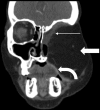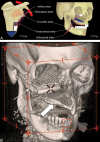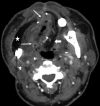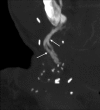Imaging of Surgical Free Flaps in Head and Neck Reconstruction
- PMID: 30409846
- PMCID: PMC7048589
- DOI: 10.3174/ajnr.A5776
Imaging of Surgical Free Flaps in Head and Neck Reconstruction
Abstract
Head and neck surgical reconstruction is complex, and postoperative imaging interpretation is challenging. Surgeons now use microvascular free tissue transfer, also known as free flaps, more frequently in head and neck reconstruction than ever before. Thus, an understanding of free flaps, their expected appearance on cross-sectional imaging, and their associated complications (including tumor recurrence) is crucial for the interpreting radiologist. Despite the complexity and increasing frequency of free flap reconstruction, there is no comprehensive head and neck resource intended for the radiologist. We hope that this image-rich review will fill that void and serve as a go to reference for radiologists interpreting imaging of surgical free flaps in head and neck reconstruction.
© 2019 by American Journal of Neuroradiology.
Figures
















Similar articles
-
Preimaging and Postimaging of Graft and Flap in Head and Neck Reconstruction.Magn Reson Imaging Clin N Am. 2022 Feb;30(1):121-133. doi: 10.1016/j.mric.2021.07.004. Magn Reson Imaging Clin N Am. 2022. PMID: 34802575 Review.
-
Head and neck reconstructive surgery: what the radiologist needs to know.Eur Radiol. 2016 Oct;26(10):3345-52. doi: 10.1007/s00330-015-4184-3. Epub 2016 Jan 20. Eur Radiol. 2016. PMID: 26787606 Review.
-
Surgical Free Flaps and Grafts in Head and Neck Reconstruction: Principles and Postoperative Imaging.Neuroimaging Clin N Am. 2022 Feb;32(1):75-91. doi: 10.1016/j.nic.2021.09.002. Neuroimaging Clin N Am. 2022. PMID: 34809845 Review.
-
Incidence of pedicle ossification in osseous free flap reconstruction in the head and neck.Oral Oncol. 2020 Apr;103:104611. doi: 10.1016/j.oraloncology.2020.104611. Epub 2020 Feb 28. Oral Oncol. 2020. PMID: 32120341
-
Head and neck reconstruction with pedicled flaps in the free flap era.Acta Otorhinolaryngol Ital. 2016 Dec;36(6):459-468. doi: 10.14639/0392-100X-1153. Acta Otorhinolaryngol Ital. 2016. PMID: 28177328 Free PMC article.
Cited by
-
Osteocutaneous-flap-related osteomyelitis following mandibular reconstruction: a cohort study of an emerging and complex bone infection.J Bone Jt Infect. 2022 Jun 10;7(3):127-136. doi: 10.5194/jbji-7-127-2022. eCollection 2022. J Bone Jt Infect. 2022. PMID: 35855050 Free PMC article.
-
CT and MR Imaging Appearance of the Pedicled Submandibular Gland Flap: A Potential Imaging Pitfall in the Posttreatment Head and Neck.AJNR Am J Neuroradiol. 2023 Apr;44(4):481-485. doi: 10.3174/ajnr.A7825. Epub 2023 Mar 16. AJNR Am J Neuroradiol. 2023. PMID: 36927762 Free PMC article.
-
Prediction of Wound Failure in Patients with Head and Neck Cancer Treated with Free Flap Reconstruction: Utility of CT Perfusion and MR Perfusion in the Early Postoperative Period.AJNR Am J Neuroradiol. 2022 Apr;43(4):585-591. doi: 10.3174/ajnr.A7458. Epub 2022 Mar 31. AJNR Am J Neuroradiol. 2022. PMID: 35361578 Free PMC article.
-
Pre-treatment and post-treatment nasopharyngeal carcinoma imaging: imaging updates, pearls and pitfalls.Neuroradiology. 2025 Apr;67(4):1023-1047. doi: 10.1007/s00234-025-03596-z. Epub 2025 Apr 11. Neuroradiology. 2025. PMID: 40214770 Free PMC article. Review.
-
The Sublingual Gland Flap for Oral Reconstruction: Insights From a Single Institutional Experience.Int J Surg Oncol. 2024 Oct 16;2024:7386967. doi: 10.1155/2024/7386967. eCollection 2024. Int J Surg Oncol. 2024. PMID: 39445029 Free PMC article.
References
-
- Urken ML. Atlas of Regional and Free Flaps for Head and Neck Reconstruction. New York: Raven Press; 1995
Publication types
MeSH terms
LinkOut - more resources
Full Text Sources
Medical
